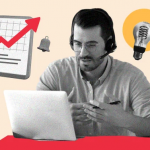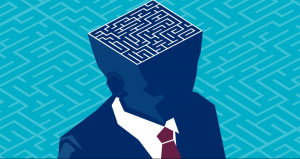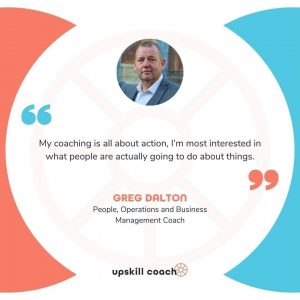What are we afraid of? Change. We like the warm fluffiness of comfort. However, it’s time for the ejector seat! We’re returning to work. We’ve been out for a while. Things will have changed. Acknowledging that fact is the first step forward. This awareness is our secret weapon. What’s next? Let’s find our inner coach and look at our attitude, our transferable skills, and our fears.
Attitude, where we’re always in the driving seat
A beautiful workday
I’m a strong believer in the power of attitude. And that we choose our attitude to each situation. Therefore, we can choose our attitude when returning to work! So, let’s do a quick exercise. It’s a bit like Seligman’s beautiful day exercise. Let’s take a moment and reflect on a time when we felt good at work. When things were going well for us.
What was going on? Where were you working? What were you doing? Who were you working with? How were you engaging with your work? Were you engaging with others? How? Let’s build that picture. Now, let’s map out the important elements for you in the workplace. These could be meaningful work, supportive colleagues, autonomy, reasonable working hours, and so on. They are individual to you.
Our inner story-teller
Our skills are transferable. Yes, it’s important to reskill regularly. But we can also re-frame existing skills. Let’s give it a try. Stay in that good place in your mind. Where you’re feeling positive about returning to work. Now it’s time to reflect on your time out of the workplace. It’s time to build a story bank. What good stories do you have? What do they say about you?
If you’ve been on maternity leave, then you’ll have some great time-management and multi-tasking tales! You might have been taking a career break to travel. If so, you’ll have wonderful stories about diversity, communication, and problem-solving. You might have been sick. In that case, the very fact that you’ve decided on returning to work is a sign of your resilience and your perseverance. You can tell the stories that got you to this point. Google’s former head of HR, Laszlo Bock, champions the power of story-telling. So, let’s tell those stories.
Wrangle with worry and win
Worry is a formidable foe. It can cannibalise our positive attitude. To manage it better, here are a few tips that I’ve recommended to my life coaching clients. They’re tried and tested!
- Give yourself permission to worry for a set period each day. And then be strict with yourself. Worry is saved for worry time.
- Take a piece of paper in the morning and write down all the things that you’re worried about. Now throw it away.
- Draw a two-column chart on a blank sheet of paper. One column for ‘If …’. Another column for ‘then I’ll …’. Now you have an action plan for any worries that materialise.
Let’s PRACTICE problem-solving
Skills for the future
Change. It’s inevitable. That doesn’t mean that we’re not relevant. It might just mean that we need to emphasise different parts of our skill sets. The World Economic Forum has mapped the journey from 2015 to 2020. Here are the top 10 skills for 2020:
PRACTICE makes perfect progress
Let’s learn a new tool that showcases the top three skills for 2020. It’s a seven-step process adapted from a tool called PRACTICE (Palmer, 2011). I’ve tweaked it a bit so that it incorporates change.
- Problem definition
- Reality check
- Alternatives
- Consequences
- Target solution
- Implement
- Changes
- Evaluate effectiveness
The nitty-gritty of problem-solving
We start with our P, the problem. Then we need to solve it. What is the problem? This can be the trickiest part. It’s like peeling an onion. We could state the problem as we see it and move on. But what if we spent a bit more time digging a little bit deeper. Subsequently, what if we did this with others? What if we brought it to our life or career coaching? We might realise that beneath the surface of the practical problem is most likely a human problem.
We check in with our R, the current reality. What’s going on? We look at the current situation and the desired outcome. And we want to close this gap. Now we get creative with our A! As Steve Jobs famously said, “creativity is just connecting things”. It’s not about being Picasso, or Mozart, or Shakespeare. It’s about taking a step outside the box and thinking differently. Here are three tips for better brainstorming. Come up with loads of ideas. Come up with varied ideas, even silly ones. And hold out on the judgement! It’s good fun. For the coach, as well as the client!
After that we can evaluate the ideas! The C is the consideration of the consequences. And it’s critical thinking time. I find it helpful to use a blank page for each option. And consider whether there are any skills or resources that I’m lacking, and who I could draw on for help, support, or advice. It could be a trusted colleague, a coach or a mentor. We can’t be experts in all domains of our lives and one of our most valuable resources is our network of connections and mentors.
It’s time for the experiment! We target a solution. Then we implement it and make any necessary changes or tweaks. And then we evaluate its effectiveness in solving the problem. Boom! We’ve PRACTICE-d our problem.
My Fears and Me
It’s all going to go horribly wrong
Let’s look at the fear of failure. This can play on repeat in our minds. It’s the monkey mind. He’s driving the cart and he’s having a field day! How can you interrupt this drama? You can ask yourself a couple of questions. What’s the worst that could happen? How could you cope with it? Now you’re consciously thinking in extremes. And this can help you to notice if you’ve been catastrophising i.e. imagining outcomes that have a very remote possibility of actually happening.
Whatever our fear, it’s a meaningful fear for us. And it’s ok to feel it. It might be a fear of disappointing others. Or a fear that we won’t be able to manage both our home life and our work life when we’re returning to work. We might be afraid that we won’t be as good as we used to be. We can put strategies in place for all these fears. But the first step is acknowledging that the fears exist. Then they can’t jump out and surprise us.
Who do you think you are?
There might also be a little sprinkle of imposter syndrome. Who do you think you are? This was a question that I heard regularly as a child, as a teenager, as a worker. How do we deal with it? Well, we wear many different hats in our lives. Daughter. Employee. Father. Friend. Wife. Boss. Manager. And so on. We’ve been out of the workplace. So we might feel less comfortable in some of our workplace hats. They might feel a bit too big. Or a bit too small. Either way, we’re aiming for a better fit.
We can’t just wave a magic wand and have Baby Bear’s hat! We have to walk in the hat for a while and wear it in again. And tap into our inner coach here. I’d suggest three questions that you can ask yourself. What does being a ‘Manager’ mean to you? Where are you strong? Where are you falling short and how can you address this? Now you have a more balanced picture of yourself as a ‘Manager’ and you have a strategy for your areas of worry when you’re returning to work.
The night before the big day
You might feel some anxiety. And that’s ok. You’re human. Simon Sinek has a great video on re-framing nerves as excitement. We can fool our body by changing the narrative. We can re-interpret how we feel and say ‘Oh, this is exciting’. And then we explain why. To ourselves. Maybe it’s exciting because it’s an amazing opportunity. Or because it’s a worthwhile cause. And so on. Our self-talk is very powerful. We know we’ve done the groundwork. We’ve addressed our fear of failure and our imposter syndrome. We can comfortably sit back and fool our body into believing that we’re excited. Because maybe we are.
And so…
We are going through a period of change. Change is never comfortable. It’s unfamiliar and a bit scary. And it’s helpful to learn to distinguish between fear of harm and fear of discomfort. Discomfort is not a bad thing. It’s how we grow. We can dance around the place and avoid our fears. Or we can face them. It’s a choice. Between courage and comfort. How often do you choose courage? Let’s share these stories.
This article was written by one of our top business coaches Susan Moran. Book a 15 min free call today to find the perfect business coach for you.







